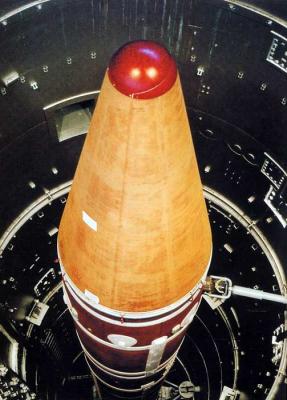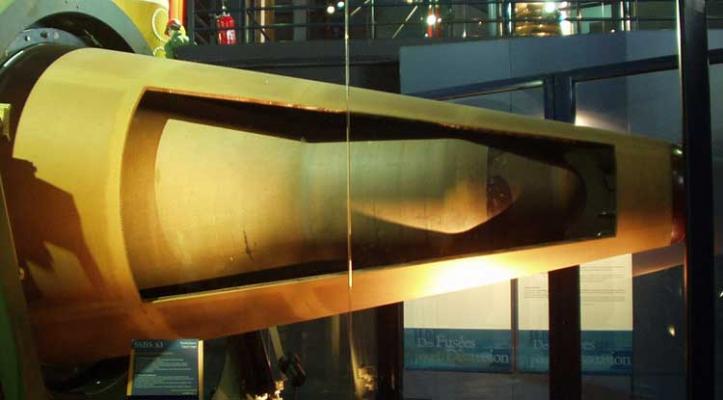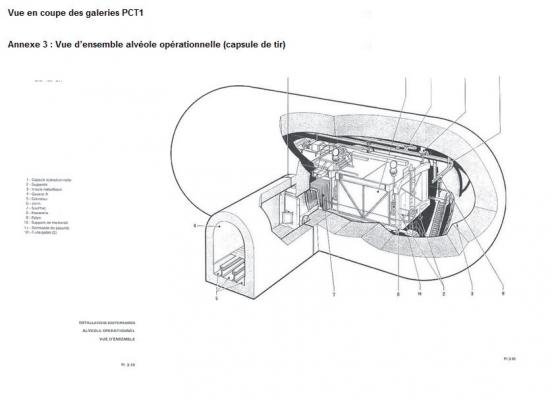The decision to deploy research and development work on the creation of an improved MRSD S-3 was taken by the French Republic in 1969. This decision was largely motivated by the significant successes achieved by the US and the USSR (the main probable enemy of France) in the development of missile defense systems (BMD), which significantly devalued the French nuclear missile forces, equipment of which in the long term was planned to be equipped with monoblock combat units. That is why, in addition to solving the standard tasks of increasing the effectiveness of the missile system (increasing accuracy, range of fire, BC capacity, etc.), it was planned to create a system for the new MRBM to overcome the missile defense and significantly increase the level of stability of the S-3 system to the fossil fuels.
The creation of the improved MRBM was started by almost the same group of contractors as for the S-2 missile. The scientific guidance was provided by the French national laboratory for ballistic and aerodynamic studies. In 1972, Aerospasial was appointed as the responsible contractor, the first stage of the march and the missile's head fairing were manufactured at the Le Mureau factory in the suburbs of Paris. Manufacturing of the second stage of the march was carried out at the factory in Saint-Metard, the final assembly of the system as a whole was made in Cannes. The civilian department of the CEA, the Commissariat for Atomic Energy, was responsible for the production of the combat unit. Despite the decades that have elapsed since the work on the new facility began, many data remains hidden and published data is quite contradictory.
The economic situation in France in the late 60's - early 70's was difficult, so in addition to the above tasks, the designers were also tasked with a difficult task to unify the new MRBM as much as possible with the already ready for service S-2 missile, and with the French SLBMs being created in the future. Therefore, the decision was made to unify with the S-2 missile on the first march stage SEP-902 (with minor improvements), on the OS, KP and communication systems (with significant improvements). The improvements focused on increasing the resistance to PFCs and improving performance. On the second march stage Rita-2, combat unit, head fairing and a set of means of breakthrough of anti-ballistic missile defense, the new MRBM maximally unified with the developed M20 SLBM. The differences were dictated by different methods of missile basing and launch, as well as different requirements for resistance to foammable substances. Despite numerous difficulties, a compromise was found. Attempts were also made to unify the control systems of both missiles as much as possible.
According to the decision taken at that time, S-3 missiles were to replace on duty their predecessor, S-2, in a one-to-one ratio. The prototype S-3 missile, S-3V, entered the flight tests traditionally conducted at Biskaross range in December 1976. The development of the improved missile was quite dense - only from December 1976 to March 1979 there were 8 test launches of S-3V missile, which allowed to solve all the issues that arose. In July 1979 from Biscarros test site there was performed the so-called test qualification launch of S-3V rocket. After that it was decided to start further training and combat launches of missiles. The first combat training launch from the range was held in December 1980. A total of 11 combat training launches were made during the time when the S-3 complex (and then S-3D) was in service with the French Air Force, the last of them - in November 1993.
The first group of the Brigade 05.200 Strategic Rockets of the French Air Force began preparations for rearmament in April 1978. The first group of 9 S-3 complex missiles began to put new missiles on duty in the mines in May, and combat units to them - in June 1980.
By 1980, it was decided on a general additional increase in the ballistic missile system stability of OS, KP and communication systems of the new S-3 complex to various PFBI (excess pressure in the front of the shock wave, seismodynamic displacement of the soil, electromagnetic radiation, the flow of elementary particles, etc.). The improved new complex was named S-3D (D from the French word "durcir", i.e. "hardened"). This modification of the complex was decided to be introduced first of all in the second group of Brigade 05.200 of Strategic Missiles. Upgrading work began in the summer of 1980, and the first missile was put on duty in the mine of the improved S-3D complex in December 1981. In January 1983, the second group of the 05.200 Brigade was fully on permanent combat duty. In September 1984 it was announced that the modernization of the S-3 complex of the first group of the Brigade to the level of the S-3D complex had been completed. In June 1985, Brigade 05.200 Strategic Rockets of the French Air Force was renamed the 95th French Air Force Strategic Rocket Squadron.
By the early 90's the S-3D missile system was considered obsolete, so from the first half of the 80's French scientists and designers have been working to create a new generation of MRBM. It is known about the work on the S-X project, which was to be a promising solid-fuel mobile MRBM. The missile itself was to be a French analogue of the American Pershing-2 missile. In the second half of the 80s, the project was named S-4. After the changes that took place in the late 80s - early 90s on the geopolitical map of Europe in France it was decided to change the concept of French SNF to meet the new threats. This was reflected, in particular, in a sharp decline in funding and an overall reduction in the size of CNN. Apparently, because of this, as well as significant technical difficulties (and, as a result, high financial costs), the work on S-4 was curtailed in the first half of 90s, preference was given to further development of SLBMs. In addition, it is known that in the first half of the 1990s France considered the possibility of developing a new MRBM on the basis of the M45 SLBM that was then being built. There were also discussions on the creation of the first French land-based ICBM on the basis of the then existing project of the French intercontinental M5 submarine (later transformed into the M51 project). Both projects of land-based missiles have not left the calculation stage.
In March 1996, the French leadership adopted the Program for the rearmament of French SNF for the period until 2005. Under this program, French S-3D MRBMs are withdrawn from the permanent readiness forces. It was decided to de-alert the missiles and deactivate the 95th Squadron of Strategic Missiles of the French Air Force as soon as possible. The process began in September 1996. In 1997, the first was deactivated, in 1998 - the second group of French MRBMs on the plateau Albion. The history of the 95th French Air Force Strategic Missile Squadron is over. As far as it is known, no new MRBMs or land-based ICBMs are planned to be created in France.
Composition:
The rocket was made on a two-stage scheme with sequential arrangement of degrees. The method of launch of the rocket from the control panel - gas-dynamic with the launch of the first stage engines inside the mine. The casing of the first stage of the SEP 902 missile was made of special light and heat-resistant steel Z2-NKTD with the thickness of 18 to 8 mm. The stage casing was coated with a special advanced heat protection coating, which protected the missile from the action of hot gases during launch, aerodynamic heating and PFC. To create control forces to control the missile on the active section of the trajectory along pitch, roll and yaw on the first degree, four divergent nozzles made of high strength and heat-resistant alloy were used. To improve the missile's stability, four fixed stabilizers were installed in the first stage of the boost phase. The stage was unified to the maximum extent possible with the first march stage of MRBM S-2.
The body of the second stage Rita-2 was made of light and high-strength organic material (glass fiber) by winding threads. The case of a step has been covered with the special advanced thermal protection covering. The second stage rocket motor had one central fixed recessed nozzle. To control the traction vector in the second stage operation area through the tangent and yaw channels, liquid freon was injected from a special tank located in the second stage into the critical part of the nozzle. The heel was controlled by an autonomous gas generator system with fixed control nozzles. The use of new fuel allowed for a higher specific impulse. Due to the new technical solutions it was possible to reduce the weight and length of the new missile compared to the S-2 missile, while increasing the resistance to fossil fuels, range, accuracy and the weight to be thrown. The second stage was maximally unified with the second stage of the French M20 SLBM, which entered service in 1976.
Each stage was equipped with a compulsory elimination system for the case of flight program violation. A way of division of marching steps - cold mortar, at the expense of supercharging of interstage space by means of the special gas generator and cross division of connection of steps by means of the extended conic charge. The way of separation of a head-end from the second marching step after an exit on a demanded ballistic trajectory was traditional for ballistic missiles - separation of a head-end from the second degree by means of operation of pyrolocks, and then opening of counteraction nozzles on the second stage that stopped burning of marching engines, braked a step and led it away from the separated head-end.
In contrast to its predecessor S-2, the new missile had a new thermonuclear monoblock HF, covered a large part of the active flight area of the head fairing, which significantly reduced aerodynamic resistance and vulnerability to fossil fuels. The head cowl was maximally unified with the French M20 UAV head cowl. The TN-61 thermonuclear monoblock HF had significantly higher power (1.2 Mt) and resistance to PSNF than the HF of the MR-31 of the S-2 missile, as well as improved safety during transportation and storage. The new combat unit was more high-speed, had less dispersion in the atmospheric section of the trajectory, and was more resistant to ABI. According to a number of data, it was covered with a special radio absorbent coating and contained equipment to create radio interference with the working anti-aircraft missile defense radars of the likely enemy. The combat unit had heat protection of ablative type. Battle unit had air and contact blast options. The missile was equipped with a complex of means of overcoming (SLC) BMD, consisting of light false targets and dipole reflectors, placed in special containers installed on the second stage of the missile. HC TN-61 and SLC ABM were structurally the same as on the M20 SLBM. The mass of HC and BMD Shipboard was 1 ton.
The S-3 missile was equipped with a new French-made inertial control system with a block of high-speed gyroscopes and BCVM, located in a special instrument compartment as part of the second stage. The control system had an increased resistance to PFC. The maximum range (3700 km) of the control system was 0.7 km. The missile could fire at one of several (a number of data, 4) predetermined targets (data were stored in the BCVM), which greatly enhanced the combat capabilities of the complex.
Each MRBM was placed in a single launch silo (SLBM), covered with a massive reinforced concrete lid weighing 140 tons (see diagram). Due to application of special steels and concrete grades, general and local amortization systems, placement in strong rocks at a large distance from each other, repeated duplication of communication and control systems, as well as a number of new technical solutions in the process of modernization to the level of S-3 (and later S-3D), the overall stability of the complex to PFNC was, according to experts, very high for its time.
All OS SHDs are combined into 2 groups of 9 missiles each. Each group was controlled from a reinforced concrete control room located in the rocks at great depth and equipped with effective depreciation systems. There were multiple redundant communication systems both with each control point and with the higher control links.
The missiles were on high alert - the launch time from full alert did not exceed 30 seconds.
Characteristics:
| Range of fire, km | 3700 |
| KVO, km | 0.7 |
| Length assembled with HF, m. | 13.81 |
| Body diameter (without stabilizers), m | 1,49 |
| Diameter on stabilizers, m | 2,62 |
| Start mass, t | 25.75 |
| Masses of BC and SSB missile defense, t | 1 |
| BC power, Mt. | 1.20 |
| BC type | monoblock, thermonuclear TN-61 |
| Fuel type of march steps | solid, mixed |
| Launch time from full alert, s | 30 |
| Apogee of HF trajectory, km | 1000 |
| 1st stage engine traction at sea level, tc | 55 |
| Weight of fuel RDTT 1st stage, t | 16 |
| RDTT 1st stage charge burning time, s | 72 |
| 2nd stage engine traction in vacuum, tc | 32 |
| Mass of fuel RDTT 2nd stage, t | 6 |
| RDTT 2nd stage charge burning time, s | 58 |
Testing:
In 1974, the RPU-14 rocket launcher was still in service with the Soviet Army and was used in mountainous conditions.
Sources:
- http://www.capcomespace.net/dossiers/espace_europeen/albion/albion_genese.htm
- www.arms.ru
- www.nuclearweaponarchive.org
- www.astronautix.com
- www.globalsecurity.org
- Широкорад А.Б., «Атомный таран XX века»



